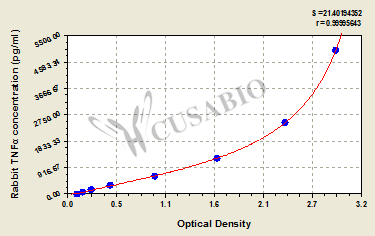| Code | CSB-E06998Rb |
| Size | 96T,5×96T,10×96T |
| Price | Request a Quote or Start an on-line Chat |
| Trial Size |
24T ELISA Kit Trial Size (Only USD$150/ kit) * The sample kit cost can be deducted from your subsequent orders of 96T full size kits of the same analyte at 1/5 per kit, until depleted in 6 months. Apply now |
| Intra-assay Precision (Precision within an assay): CV%<8% | ||||||
| Three samples of known concentration were tested twenty times on one plate to assess. | ||||||
| Inter-assay Precision (Precision between assays): CV%<10% | ||||||
| Three samples of known concentration were tested in twenty assays to assess. | ||||||
| To assess the linearity of the assay, samples were spiked with high concentrations of rabbit TNFα in various matrices and diluted with the Sample Diluent to produce samples with values within the dynamic range of the assay. | ||||||
| Sample | Serum(n=4) | |||||
| 1:1 | Average % | 86 | ||||
| Range % | 80-92 | |||||
| 1:2 | Average % | 95 | ||||
| Range % | 91-105 | |||||
| 1:4 | Average % | 98 | ||||
| Range % | 92-102 | |||||
| 1:8 | Average % | 94 | ||||
| Range % | 86-98 | |||||
| The recovery of rabbit TNFα spiked to levels throughout the range of the assay in various matrices was evaluated. Samples were diluted prior to assay as directed in the Sample Preparation section. | ||||||
| Sample Type | Average % Recovery | Range | ||||
| Serum (n=5) | 95 | 87-99 | ||||
| EDTA plasma (n=4) | 92 | 87-101 | ||||
| These standard curves are provided for demonstration only. A standard curve should be generated for each set of samples assayed. | |||||||||||||||||||||||||||||||||||||||||||||||||||||||||||||||

|
|||||||||||||||||||||||||||||||||||||||||||||||||||||||||||||||
CUSABIO's rabbit TNFα ELISA kit is an in vitro enzyme-linked immunosorbent assay for the quantitative determination of TNFα concentrations in serum, plasma, tissue homogenates, and cell lysates. This assay exclusively recognizes rabbit TNFα. The quantitative sandwich ELISA technique of this kit is based on TNFα antibody-TNFα antigen interactions and an HRP colorimetric detection system to detect the levels of TNFα in samples. The intensity of the color is positively proportional to the amount of bound TNFα in the initial step.
TNFα, commonly referred to as TNF, is a pleiotropic cytokine that plays an essential role in the innate and adaptive immune systems. It is also involved in tissue regeneration, and repair, as well as the modulation of embryonic development, the sleep-wake cycle, lymph node follicle, and germinal center formation. TNF signals through TNFR1 and TNFR2, activate NF-κB and MAPK signaling pathways regulating cell proliferation, survival, differentiation, and apoptosis. Due to its pro-inflammatory properties, TNF is implicated in inflammatory diseases, such as rheumatoid arthritis, Crohn's disease, and psoriatic arthritis. Increased TNF expression has been found in various cancer types. Especially, in breast cancer, TNF is associated with enhanced tumor cell proliferation, higher malignancy grade, increased occurrence of metastasis, and generally poor prognosis for the patient.
Sample type: Tissue homogenate(Liver and intestine)
Sample species: Rabbit
Review: I tried the kit to determine the best working dilution (starting concentration 100mg/mL). In the case of liver the best result was obtained with 5x-10x dilution, and for intestine the best results were using undiluted sample to 2x dilution.
By Anonymous